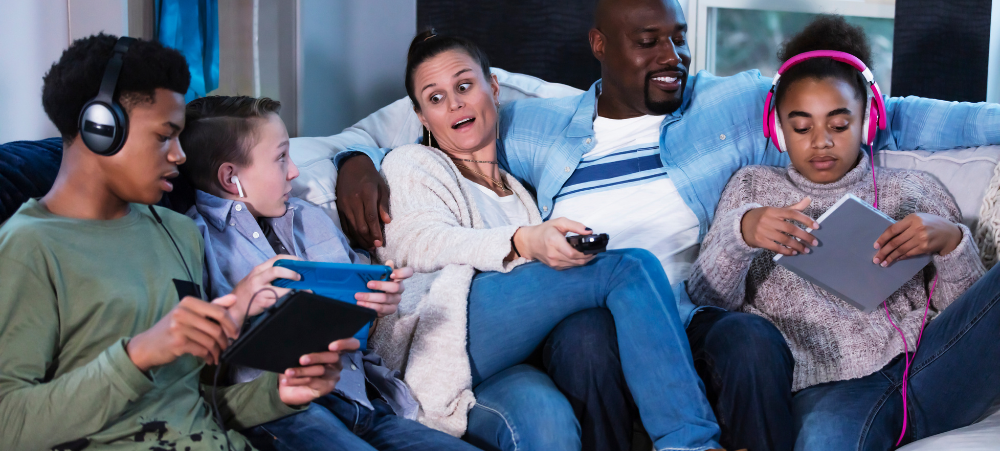In today’s digital age, screens are omnipresent—whether it’s smartphones, tablets, computers, or televisions. While these devices offer numerous benefits, excessive screen time can lead to various health and well-being issues. Striking a balance between screen use and other activities is crucial for maintaining physical, emotional, and cognitive health.
📱 Understanding the Impact of Excessive Screen Time
Excessive screen time, especially when it involves passive consumption like endless scrolling or binge-watching, can have detrimental effects on both children and adults. For children, overuse of screens can lead to issues such as:
- Physical Health Concerns: Prolonged screen time is associated with sedentary behavior, which can contribute to obesity and related health problems.
- Sleep Disruptions: The blue light emitted by screens can interfere with the production of melatonin, a hormone that regulates sleep, leading to difficulties falling asleep and poor sleep quality.
- Mental Health Issues: Excessive screen time has been linked to increased risks of anxiety, depression, and attention problems.
For adults, the consequences can include:
- Increased Stress and Anxiety: Constant connectivity can lead to information overload and heightened stress levels.
- Reduced Social Interactions: Spending more time on screens can decrease face-to-face interactions, leading to feelings of isolation.
- Physical Strain: Extended screen use can cause eye strain, headaches, and musculoskeletal problems.
🧠 Strategies for Managing Screen Time
To achieve a healthy balance, consider implementing the following strategies:
1. Set Screen Time Limits
Establish daily or weekly screen time limits to ensure that screen use does not interfere with other important activities. For instance, the American Academy of Pediatrics recommends no more than two hours of recreational screen time per day for children.
2. Create Screen-Free Zones
Designate certain areas in your home, such as the dining room or bedrooms, as screen-free zones. This encourages face-to-face interactions and promotes better sleep hygiene.
3. Encourage Alternative Activities
Promote activities that do not involve screens, such as reading, outdoor play, or engaging in hobbies. This helps to reduce reliance on screens for entertainment.
4. Model Healthy Screen Habits
Adults should model healthy screen habits for children by limiting their own screen time and prioritizing other activities. Children are more likely to adopt these behaviors if they see them practiced by adults.
5. Use Technology to Manage Screen Time
Utilize built-in features on devices, such as screen time trackers and app usage monitors, to keep track of screen time and set limits. There are also third-party apps available that can help manage screen time effectively.
🛌 Prioritizing Sleep
Adequate sleep is essential for overall health. To promote better sleep:
- Implement a Digital Curfew: Avoid screen use at least one hour before bedtime to help the brain wind down.
- Reduce Blue Light Exposure: Use settings or apps that reduce blue light emission from screens during evening hours.
- Create a Relaxing Bedtime Routine: Engage in calming activities, such as reading or meditation, to prepare for sleep.
👨👩👧 Involving the Whole Family
Creating a family media plan can help set clear expectations and priorities for screen use. This plan can include designated screen-free times and areas in the home, as well as guidelines for appropriate content. Involving children in the development of this plan can foster a sense of responsibility and cooperation.
🌱 The Importance of Digital Detox
Regular breaks from screens, known as digital detoxes, can help reduce stress and improve overall well-being. These breaks allow individuals to reconnect with the physical world and engage in activities that promote mental and physical health.
🔄 Reflecting on Screen Time Habits
Regularly assess your screen time habits and their impact on your life. Consider questions like:
- How does screen time affect my mood and energy levels?
- Am I using screens in ways that align with my personal values and goals?
- Are there areas where I can reduce screen time to improve my well-being?
By reflecting on these questions, you can make informed decisions about your screen time habits and make adjustments as needed.
Sources:
- Common Sense Education. (n.d.). Finding Balance in a Digital World. https://www.commonsense.org/education/digital-citizenship/lesson/finding-balance-in-a-digital-world
- St. Nicholas College. (2024, February 28). Screen Time Solutions: Striking a Healthy Balance in a Digital World. https://stnicks.org.au/news/screen-time-solutions-striking-a-healthy-balance-in-a-digital-world/
- Listening. (n.d.). 5 Effective Tips to Reduce Screen Time and Find Balance. https://www.listening.com/blog/5-effective-tips-to-reduce-screen-time-and-find-balance
- Second Step. (2024, December 11). Mindful Tech: Balancing Screen Time and Well-Being. https://www.secondstep.org/blog/mindful-tech-balancing-screen-time-and-well-being
- National Institutes of Health. (2025, April 1). 7 Tips for Managing Screen Use. https://magazine.medlineplus.gov/article/7-tips-for-managing-screen-use
We understand that there are many aspects that encompass a Mother, Father or Child and strive toward providing resources and services that accommodates this.
Our content is aimed to inform and educate families on issues starting from pregnancy through to the challenges of the teen-age years.
- Tiny Toons Looniversity Returns: Meet the Voice Behind Plucky and Hamton! - December 12, 2025
- From Pain to Possibility: Panado®’s New Marketing Campaign, Highlights The Joy Of Pain Relief - December 10, 2025
- Feeding Unicorns by Jeni-Anne Campbell: A bold new book for business leaders who care - December 9, 2025





